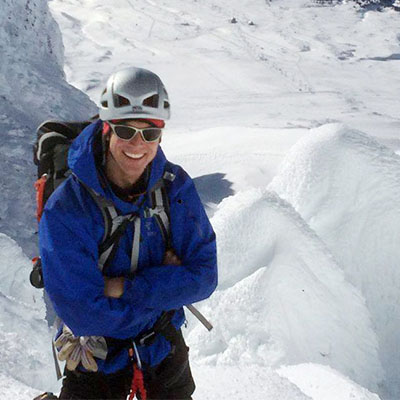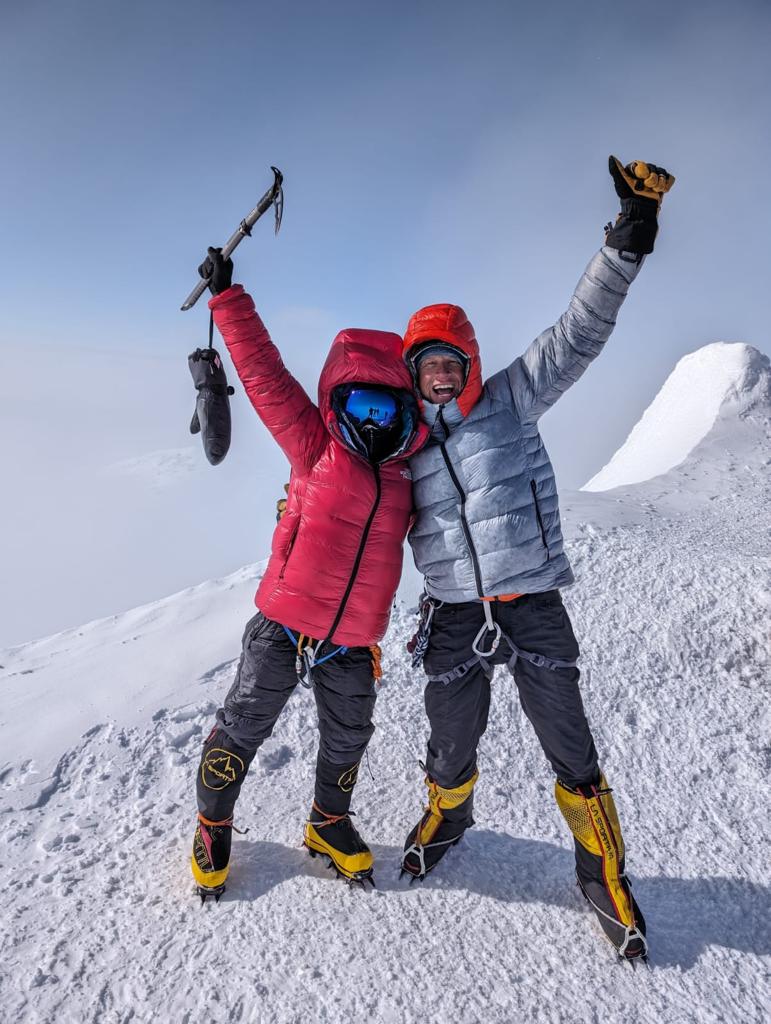Due to its location near the Atacama Desert, the mountain has very dry conditions, with snow usually only remaining on the peak during winter, though heavy storms can cover the surrounding area with a few feet of snow even in summer. Despite the generally dry conditions, there is a permanent crater lake about 100m/330ft in diameter at an elevation of 6390m/20,960ft on the eastern side of the mountain. This is most likely the highest lake of any kind in the world.
The ascent of Ojos del Salado is mostly a hike except for the final section to the summit which is a difficult scramble that may require ropes. The first ascent was made in 1937 by Jan Alfred Szczepański and Justyn Wojsznis, members of a Polish expedition in the Andes.
Its name, meaning roughly “eyes of salt” in Spanish, comes from the enormous deposits of salt that, in the form of lagoons or “eyes”, appear in its glaciers. An international highway between Chile and Argentina runs north of the mountain.
photo credits: Ted Hesser, Carlos Valera
- Itinerary
- Dates and Costs
- Gear List
- Why Madison Mountaineering?
Day 01: ARRIVE COPIAPÓ – TRANSFER BY VEHICLES TO EL SALVADOR. You will be met at arrival to Copiapó and start your trip towards the highlands. The acclimatization process starts with a first night in El Salvador, a mining town where few tourists go. Accommodation will be rather modest but spending this first night at 2600m/8,530ft will enable us to proceed to a higher camp next day. Briefing with the mountain guide and equipment check. [no meals included]
Day 02: PEDERNALES SALT FLAT (drive 90 km/56 mi). We start driving east towards the Altiplano, we drive to our first camp next to Pedernales Salt Flat (3362m/11,030ft). We are now in the middle of the Chilean high plateau, the southernmost part of the Atacama Desert and home to a great diversity of wildlife such as flamingoes and foxes. In the evening, we take a short walk to the nearby lagoon where we see local flora and fauna and a large variety of birds. [B, L, D]
Day 3: CLIMB CERRO DOÑA INES (5070m/16,634ft) Early transfer by 4×4 to the base of Cerro Doña Inés (4500m/14,763ft). The climbing to the summit will take 5 to 6 hours round trip and allow for an amazing view of the surroundings. We descend and overnight at our base camp next to Pedernales Salt Flat (3362m/11,030ft). [B, L, D]
Day 4: TRANSFER TO LAGUNA VERDE Today we will drive along Maricunga salt flat, check in the Maricunga customs for our Ojos del Salado climb, and then keep going across the high plateaus to reach Laguna Verde. We set up a base camp nearby the lake, at the hot springs site (4350m/14,271ft). [B, L, D]
Day 5: CLIMB CERRO SAN FRANCISCO (6018m/19,744ft). We make an alpine start in the early morning and approach the mountain with the 4×4 (4800m/15,748ft). It is a full day climbing this beautiful mountain located at the very border between Chile and Argentina. The summit is at 6018m/19,744ft and we will need around 6 to 8 hours to reach the top. We descend and overnight at our lake-side camp (4350m/14,271ft). [B, L, D]
Day 6: LAGUNA VERDE REST DAY. Full day to rest and get ready to move to Ojos del Salado Base Camp. This extra day at 4350m/14,271ft is a great boost to your acclimatization process and should be fully used to recover from the Cerro San Francisco climb, hydrate and relax. Going for another hike on this day won’t be of any help to your body. We strongly recommend bringing books and music with you and just enjoy this rest day. Please note that the expedition leader may choose to skip this rest day according to the weather forecast in case a modification of the itinerary is needed to ensure the summit. [B, L, D]
Day 7: OJOS DEL SALADO – BASE CAMP (ATACAMA HUT) (drive 38 km /23 mi). Today we leave Laguna Verde and the international road to Argentina, heading to the foothill of Ojos del Salado. We drive off road, gaining altitude very quickly as we cross sand flats and steep rocky, sometimes snow-covered, slopes. Finally, we arrive at the Atacama refuge area, where we set up our base camp (5255m/17,240ft). [B, L, D]
Day 8: CARRY TO CAMP 1 (TEJOS HUT) (5825m/19,110ft). Today, we carry some equipment and food to Camp 1 – the Tejos Hut, following the sandy and rocky slopes. We cache our gear in the mountain hut, take a look around and descend back down to the base camp at the Atacama Hut (5255m/17,240ft). This hike is part of our acclimatization to maximize our chances of reaching the summit. [B, L, D]
Day 9: MOVE TO CAMP 1 (5825m/19,110ft). Today we move up to Camp 1 carrying the rest of the gear we will need for the summit. It is a short day we arrive early to get hydrated, eat and rest for the summit day. [B, L, D]
Day 10: OJOS DEL SALADO SUMMIT DAY (6893m/22,614ft). We make an alpine start (3 AM – 5 AM) depending on the wind and cold conditions and climb 8 to 9 hours up to the summit (6893m/22,615ft). The terrain may be snowy or dry. The climb includes an easy climbing/scrambling step just before getting to the summit. We will use our climbing harnesses and helmets and rope-up for this last part. From the top we have an amazing view over all major summits in the area, including Tres Cruces and Pissis. Going down we may stop for the night at Camp 1 or descend directly to base camp. [B, L, D]
Day 11: RETURN TO COPIAPÓ. Dismantle of camp and tents, organize gear and packing, load equipment and get the vehicles ready to go. Then we drive back to Copiapó, where we arrive 6 hours later. Transfer to Hotel Atacama Suites Copiapó (4 star) or similar. [B, L]
Day 12: PROGRAM CONCLUSION. You will be transfer to Copiapó airport and we conclude our program. Fly to Santiago, continue onward to your home country.
Actual schedule subject to change due to route conditions, weather, and team health.
Ojos del Salado Climb
- February 8 - 19, 2024
- December 8 - 19, 2024
Deposit: USD 3,500
Costs Include:
- Transfer In and Out (Airport-Hotel-Airport)
- Private transportation throughout the entire trip. One 4×4 for the expedition and for the airport transfer
- Base camp manager
- Local mountain guides according to size group
- Meals as mentioned in the itinerary: full board while in expedition [B: Breakfast, L: Lunch or Box-Lunch, D: Dinner]
- Accommodation as mentioned in the itinerary: Two nights in double occupancy room in a 4-star hotel at Copiapó; Ten nights camping in double occupancy tents
- All activities as mentioned in the program
- High quality communal camping gear including mess tents, sleeping tents, thick mattresses, as well as full base camp infrastructure and services
- First aid kit and pulse oximeter
- Medical Oxygen for emergencies
- VHF radio communication
- One Satellite phone (on pay per minute basis)
- DIFROL permit (a governmental authorization issued by the Ministry of Foreign Affairs, needed only by non-Chilean mountaineers, to climb summits located close to the country borders)
- 24/7 support and assistance
Costs Do Not Include:
- Bank transfer fees, if applicable
- Airfare
- additional airport transfers
- Excess baggage charges
- Meals in while in the cities or off the mountain
- Trip cancelation insurance (highly recommended) or the required medical evacuation insurance
- Comprehensive medical exam: a physician-signed Medical Release Form is required
- Alcoholic beverages
- Bottled or canned beverages
- Specialty coffee or espresso drinks
- Additional activities or visits not described in the itinerary
- Mountain porter services
- All expenses incurred in the event of early departure (evacuation fees, transport, extra hotel nights, etc.)
- Charges incurred as a result of delays beyond the control of Madison Mountaineering, LLC
- Personal communication (phone, fax, e-mail) between Chile and home country
- Personal gear, clothing and sleeping equipment (see gear list)
- Gratuities
Cancellation/Refund Policy
- There are no refunds for the deposit or balance payments for this expedition. This includes but is not limited to, expeditions that conclude without reaching or making progress towards expedition objective(s) (for example, the summit) due to route conditions, weather, insufficient manpower, or any other factor outside the control of Madison Mountaineering.
- Expedition leader has the final say on the expedition conclusion and will make all best efforts towards reaching expedition objective(s) within our margin of safety.
- Participants that choose to leave an active expedition for any reason are not entitled to any refunds
- Madison Mountaineering, LLC highly recommends trip cancellation insurance for all expeditions
- Due to the nature and heavy costs of government and operator permits, Madison Mountaineering must adhere to a stringent refund policy
- Deposit due with registration materials
- All balances are due 120 days prior to departure date unless otherwise specified
- Participants whose balances are not received by the 120-day deadline as stated above, risk forfeiture of their funds and their place on the expedition
Note: Madison Mountaineering, LLC reserves the right to waive any fees. As we offer personalized service, we will attempt to accommodate changes and cancellations when necessary, waiving certain fees when feasible. Deposits paid by participants acknowledge the above cancellation terms.
Base Layers
- Synthetic Short Underwear (2-3 pair): non-cotton style underwear
- Lightweight Long Underwear (1-2 pair): long sleeve shirt and long pants
- Heavyweight Long Underwear (1 pair)
- Short Sleeve Synthetic Shirt (1-2)
Mid Layers
- Soft Shell Jacket: to be worn over other layers
- Soft Shell Pants: very breathable and water repellant
- Lightweight Nylon Pants (optional)
Windproof/Rain Layers
- Hard Shell Jacket with hood: waterproof and breathable shell jacket
- Hard Shell Pants: waterproof and breathable shell pants
Insulation Layers
- Insulated Down or Synthetic Jacket with hood
- Insulated Pants (optional)
Headwear
- Warm Hat: synthetic or wool hat (ski hat)
- Balaclava: to protect your neck and face in high winds
- Baseball Cap or other sun hat: to shade your face/neck from the sun on a hot day
- Bandana or Buff: to protect your neck/face from the sun
Eyewear
- Glacier Glasses: full protection with side covers or wrap around
- Ski Goggles: to be worn in the event of high winds
Gloves
- Lightweight Synthetic Liner Gloves: for wearing on warm days
- Soft Shell Gloves: to wear for moderate cold/wind
- Shell Glove with Insulated Liner: to wear for severe cold/strong wind
- Expedition Mitts: large enough to fit a liner glove inside
Footwear
- Liner Socks (3 pairs)
- Wool or Synthetic Socks (3 pairs)
- Mountaineering Boots
- Hiking Shoes/Boots: comfortable hiking boots
- Gaiters
- Water Shoes or Sandals: for our camp near the hot springs at Laguna Verde
- Booties (optional): for wearing around camp
Sleeping Equipment
- Sleeping Bag: rated to at least -20°F
- Self-inflating Sleeping Pad: full length is preferred
- Closed-cell Foam Pad: to be used in conjunction with the inflating pad for warmth and comfort when sleeping
- Earplugs
Mountaineering Gear
- Expedition Backpack: approximately 50L
- Compression Stuff Sacks: for reducing the volume of the sleeping bag, down parka, etc. in your pack
- Trash Compactor Bags: to line backpack and stuff sacks as well as for separating gear
- Backpack Rain Cover (optional)
- Trekking Backpack: to carry on the trek to base camp. Simple and light.
- Trekking Poles with Optional Snow Baskets: adjustable
- Ice Axe: general mountaineering tool (~60cm)
- Crampons: general mountaineering crampons
- Climbing Helmet (optional): must be able to fit over your warm hat
- Alpine Climbing Harness: mountaineering harness, with adjustable leg loops. Not a rock-climbing “sport” harness recommended
- Headlamp: with 2 extra sets of new batteries
Travel Items
- Large Duffel Bag with Lock: for storing gear in our camps while climbing. No hard sides or wheels
- Small Duffel Bag with Lock: to store items in the hotel(s) while on the climb
- Travel Clothes: for days in cities and towns
- Lightweight journal, sketchbook, pencils, pen
- U.S. cash: for currency exchange to purchase SIM cards or merchandise in cities and villages
Additional Food Items
- Snack Food: bring a few days’ supply of your favorite climbing snack food such as bars, gels, nuts, beef jerky, etc. variety of salty and sweet is good
Other Equipment
- Water Bottles (2): wide mouth bottles with 1-liter capacity
- Water Bottle Parkas (2): fully insulated with zip opening
- Thermos (optional): 1-liter
- Water Treatment
- Sunscreen: SPF 40 or better
- Lip Screen (2 sticks): SPF 30 or better
- Toiletry Bag: include toothbrush, toothpaste, toilet paper, baby wipes and hand sanitizer (2 small bottles)
- Pee Bottle: 1-liter minimum bottle for convenience at night in the tent
- Female Urination Device (FUD)
- Knife or Multi-tool (optional)
- Small Personal First-aid Kit: include athletic tape, band-aids, Ibuprofen, blister care, etc.
- Medications and Prescriptions: bring antibiotics (Azithromycin, etc.), and altitude medicine such as Diamox, etc.
- Handkerchiefs/Bandanas (optional)
- Swim Suit for the hot springs at Laguna Verde and the beach at Bahía Inglesa.
- Towel for the hot springs and the beach
- Hand and toe warmers
Optional Electronics
- Country-appropriate power plug adapters and power transformers
- Adventure Sports Watch: such as Garmin fēnix 6
- GPS/Personal Satellite Communicator: such as Garmin inReach Mini
- Personal Power System: such as Goal Zero Nomad 28 Plus Solar Panel and Sherpa 100AC Power Bank
- Digital Entertainment: movies, tv shows, music, books loaded on to smartphone, iPad, Kindle
- Camera: bring extra batteries, charger, and memory cards
Madison Mountaineering is recognized for well thought out strategy in leading high altitude climbing expeditions, as well as high-quality service throughout. We have two decades of experience in the planning and coordination of mountaineering expeditions, our reputation is excellent. We strive to make each expedition the best possible experience for our climbers and focus on our 3 primary goals of success in reaching the summit, returning safely, and having fun! Safety is always our number one priority.
Our guides are some of the best and most experienced in the industry, having a strong grasp of technical climbing, expedition, and high altitude experience, along with strong interpersonal skills. Our teams are small and equipped with the best support available to ensure the highest chance of success. We are renowned for our comfortable base camps, high-quality food, first-rate communications, and medical support services, all of which are overseen by a professional member of our team.
Most of our climbers have either climbed with us before, been referred by a friend who has climbed with us, or met one of our teams while attempting another peak and decided to join us for their next expedition. We work hard to facilitate safe, successful, and enjoyable expeditions for all of our climbers. Our track record and past climber testimonials prove we are highly competent experts in our field and love what we do!

























